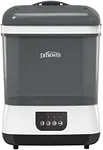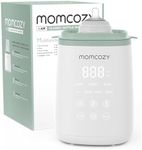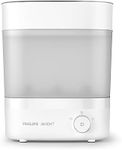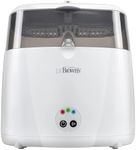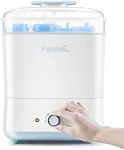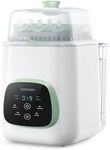Buying Guide for the Best Baby Bottle Sterilizers
Choosing a baby bottle sterilizer is an important decision for parents who want to ensure their baby's feeding equipment is clean and safe. Sterilizers help eliminate harmful germs and bacteria that can linger on bottles, nipples, and other feeding accessories. When picking a sterilizer, it's important to consider your daily routine, the number of bottles you use, and the space you have available. Understanding the key features will help you find a sterilizer that fits your lifestyle and keeps your baby's feeding items hygienic.Sterilization MethodThe sterilization method refers to how the device kills germs and bacteria. The most common methods are steam, UV light, and microwave. Steam sterilizers use hot steam to disinfect, which is effective and chemical-free. UV sterilizers use ultraviolet light to kill germs, offering a dry and often faster process. Microwave sterilizers use your microwave to generate steam inside a special container. When choosing, think about your convenience and kitchen setup. Steam and UV models are great for countertop use, while microwave options are compact and portable, ideal for travel or small spaces.
CapacityCapacity means how many bottles and accessories the sterilizer can hold at once. Some sterilizers fit just a couple of bottles, while others can handle several bottles plus nipples, pacifiers, and pump parts. If you have twins or use many bottles daily, a larger capacity saves time by sterilizing more items in one go. For occasional use or if you have limited space, a smaller unit may be more practical. Consider your daily bottle usage to decide what size works best for you.
Cycle TimeCycle time is how long the sterilizer takes to complete a sterilization process. Some models work in as little as a few minutes, while others may take up to half an hour. If you need bottles ready quickly, a shorter cycle time is helpful, especially during busy mornings or nighttime feedings. If speed is less important, a longer cycle may be fine, especially if you can set it and forget it. Think about your routine and how quickly you need clean bottles.
Drying FunctionSome sterilizers include a drying function, which dries bottles and accessories after sterilizing. This is convenient because it prevents water spots and reduces the risk of bacteria growing on damp items. If you want bottles ready to use right away, look for a model with drying. If you don’t mind air-drying or have time to let items dry naturally, a basic sterilizer without this feature may be enough.
Ease of CleaningEase of cleaning refers to how simple it is to keep the sterilizer itself clean and free from limescale or residue. Some models have removable parts or wide openings that make cleaning easier, while others may require more effort. Regular cleaning is important to keep the sterilizer working well and to avoid buildup that could affect performance. If you prefer low-maintenance products, look for a sterilizer that’s easy to take apart and wash.
Size and StorageThe size and storage aspect is about how much space the sterilizer takes up on your countertop or in your cabinets. Larger models may offer more capacity but can be bulky, while compact models are easier to store but may hold fewer items. Consider your kitchen space and whether you want to keep the sterilizer out all the time or put it away between uses. Choose a size that fits your available space and storage preferences.
CompatibilityCompatibility means whether the sterilizer fits the types and sizes of bottles and accessories you use. Some sterilizers are designed for specific brands or shapes, while others are more universal. If you use wide-neck, tall, or specialty bottles, check that the sterilizer can accommodate them. Make sure the sterilizer works with your current and future feeding gear to avoid frustration.
